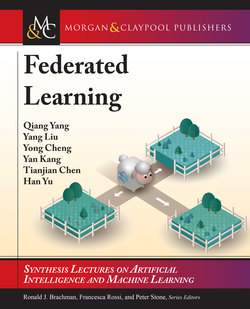Читать книгу Federated Learning - Yang Liu - Страница 7
На сайте Литреса книга снята с продажи.
ОглавлениеContents
Preface
Acknowledgments
1 Introduction
1.1 Motivation
1.2 Federated Learning as a Solution
1.2.1 The Definition of Federated Learning
1.2.2 Categories of Federated Learning
1.3 Current Development in Federated Learning
1.3.1 Research Issues in Federated Learning
1.3.2 Open-Source Projects
1.3.3 Standardization Efforts
1.3.4 The Federated AI Ecosystem
1.4 Organization of this Book
2 Background
2.1 Privacy-Preserving Machine Learning
2.2 PPML and Secure ML
2.3 Threat and Security Models
2.3.1 Privacy Threat Models
2.3.2 Adversary and Security Models
2.4 Privacy Preservation Techniques
2.4.1 Secure Multi-Party Computation
2.4.2 Homomorphic Encryption
2.4.3 Differential Privacy
3 Distributed Machine Learning
3.1 Introduction to DML
3.1.1 The Definition of DML
3.1.2 DML Platforms
3.2 Scalability-Motivated DML
3.2.1 Large-Scale Machine Learning
3.2.2 Scalability-Oriented DML Schemes
3.3 Privacy-Motivated DML
3.3.1 Privacy-Preserving Decision Trees
3.3.2 Privacy-Preserving Techniques
3.3.3 Privacy-Preserving DML Schemes
3.4 Privacy-Preserving Gradient Descent
3.4.1 Vanilla Federated Learning
3.4.2 Privacy-Preserving Methods
3.5 Summary
4 Horizontal Federated Learning
4.1 The Definition of HFL
4.2 Architecture of HFL
4.2.1 The Client-Server Architecture
4.2.2 The Peer-to-Peer Architecture
4.2.3 Global Model Evaluation
4.3 The Federated Averaging Algorithm
4.3.1 Federated Optimization
4.3.2 The FedAvg Algorithm
4.3.3 The Secured FedAvg Algorithm
4.4 Improvement of the FedAvg Algorithm
4.4.1 Communication Efficiency
4.4.2 Client Selection
4.5 Related Works
4.6 Challenges and Outlook
5 Vertical Federated Learning
5.1 The Definition of VFL
5.2 Architecture of VFL
5.3 Algorithms of VFL
5.3.1 Secure Federated Linear Regression
5.3.2 Secure Federated Tree-Boosting
5.4 Challenges and Outlook
6 Federated Transfer Learning
6.1 Heterogeneous Federated Learning
6.2 Federated Transfer Learning
6.3 The FTL Framework
6.3.1 Additively Homomorphic Encryption
6.3.2 The FTL Training Process
6.3.3 The FTL Prediction Process
6.3.4 Security Analysis
6.3.5 Secret Sharing-Based FTL
6.4 Challenges and Outlook
7 Incentive Mechanism Design for Federated Learning
7.1 Paying for Contributions
7.1.1 Profit-Sharing Games
7.1.2 Reverse Auctions
7.2 A Fairness-Aware Profit Sharing Framework
7.2.1 Modeling Contribution
7.2.2 Modeling Cost
7.2.3 Modeling Regret
7.2.4 Modeling Temporal Regret
7.2.5 The Policy Orchestrator
7.2.6 Computing Payoff Weightage
7.3 Discussions
8 Federated Learning for Vision, Language, and Recommendation
8.1 Federated Learning for Computer Vision
8.1.1 Federated CV
8.1.2 Related Works
8.1.3 Challenges and Outlook
8.2 Federated Learning for NLP
8.2.1 Federated NLP
8.2.2 Related Works
8.2.3 Challenges and Outlook
8.3 Federated Learning for Recommendation Systems
8.3.1 Recommendation Model
8.3.2 Federated Recommendation System
8.3.3 Related Works
8.3.4 Challenges and Outlook
9 Federated Reinforcement Learning
9.1 Introduction to Reinforcement Learning
9.1.1 Policy
9.1.2 Reward
9.1.3 Value Function
9.1.4 Model of the Environment
9.1.5 RL Background Example
9.2 Reinforcement Learning Algorithms
9.3 Distributed Reinforcement Learning
9.3.1 Asynchronous Distributed Reinforcement Learning
9.3.2 Synchronous Distributed Reinforcement Learning
9.4 Federated Reinforcement Learning
9.4.1 Background and Categorization
9.5 Challenges and Outlook
10 Selected Applications
10.1 Finance
10.2 Healthcare
10.3 Education
10.4 Urban Computing and Smart City
10.5 Edge Computing and Internet of Things
10.6 Blockchain
10.7 5G Mobile Networks
11 Summary and Outlook
A Legal Development on Data Protection
A.1 Data Protection in the European Union
A.1.1 The Terminology of GDPR
A.1.2 Highlights of GDPR
A.1.3 Impact of GDPR
A.2 Data Protection in the USA
A.3 Data Protection in China
Bibliography
Authors’ Biographies
